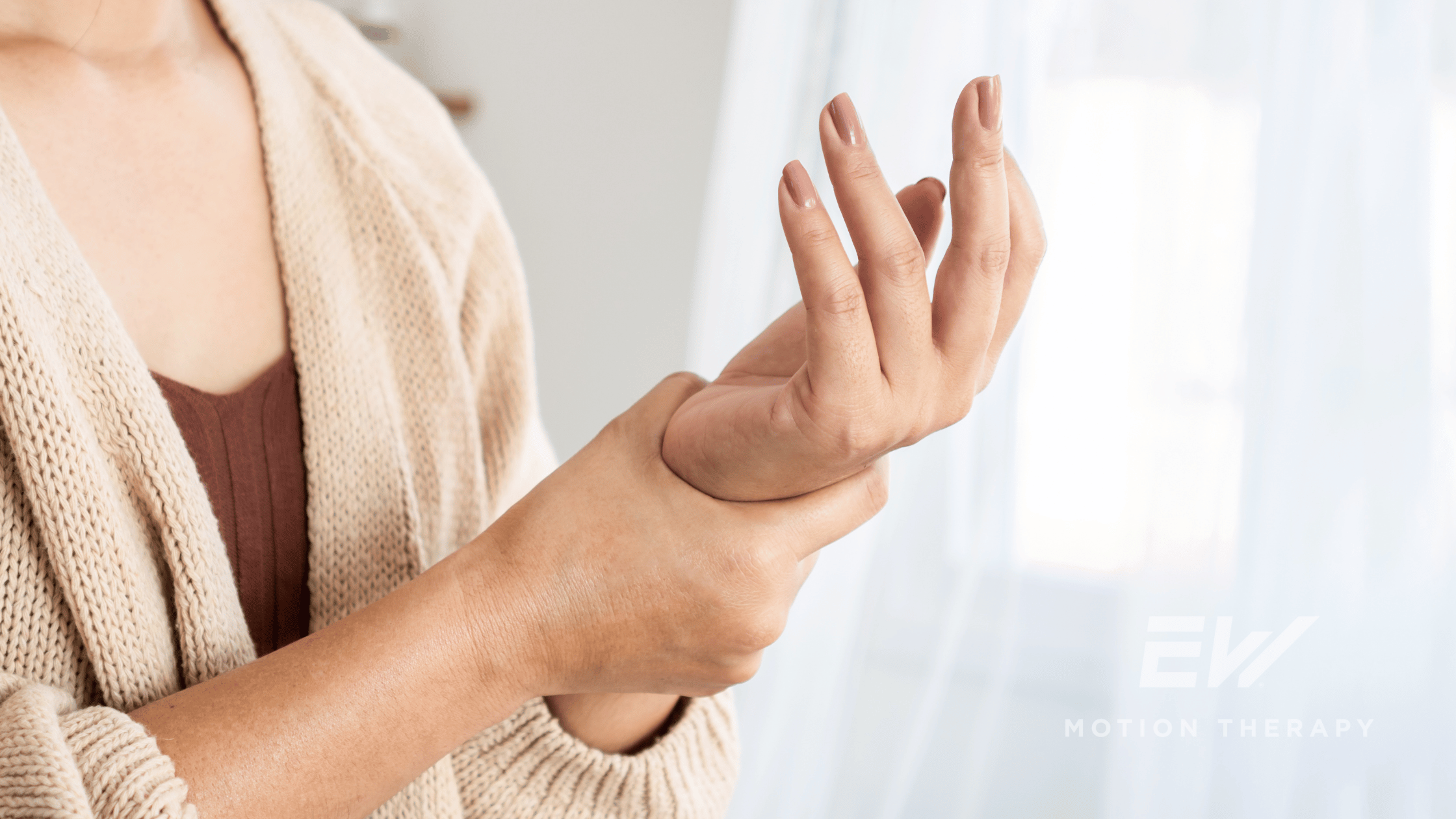Carpal Tunnel During Pregnancy: Causes, Symptoms, and Pain Relief Strategies

Licensed Physical Therapist, PT, DPT // Clinical Director, EW Motion Therapy Trussville // EW Yoga Instructor // EW Motion Therapy Trussville
Carpal tunnel syndrome (CTS) is a well-known condition that causes tingling, numbness, and pain in the hand and fingers. Many people experience CTS due to repetitive strain or prolonged computer use, but what some may not know is that it can also be common during pregnancy. Pregnancy brings about many physical changes as the body adapts to support the growing baby, and one of those changes can make women more susceptible to carpal tunnel syndrome. Understanding the causes, recognizing the symptoms, and learning effective ways to manage carpal tunnel pain at home can help women experiencing this condition find much-needed relief. Additionally, physical therapy can play a significant role in reducing discomfort and enhancing function.
What is carpal tunnel syndrome?
Carpal tunnel syndrome occurs when pressure on the median nerve within the wrist causes pain, numbness, tingling, and sometimes weakness in the hand and fingers. The carpal tunnel is a narrow passageway formed by ligaments and bones, housing the median nerve and tendons that help control finger movements. When the tissues surrounding the median nerve swell or become compressed, they increase pressure on the nerve, leading to CTS symptoms. While it’s often associated with repetitive movements or occupations that strain the wrist, physiological changes, such as those experienced during pregnancy, can also bring on the condition.

Why does carpal tunnel syndrome occur during pregnancy?
During pregnancy, the body undergoes numerous changes that can increase the likelihood of developing carpal tunnel syndrome. Here are some of the primary contributing factors:
- Fluid retention: Pregnancy often leads to increased fluid retention, which can cause swelling in various parts of the body. This swelling, particularly in the wrists and hands, can put pressure on the median nerve within the carpal tunnel, causing CTS symptoms to appear.
- Hormonal changes: Hormones such as relaxin are elevated during pregnancy to allow the ligaments to stretch and support a growing uterus. However, this hormone doesn’t only affect the lower body; it can also impact the ligaments in the wrist, contributing to carpal tunnel by increasing pressure within the wrist.
- Weight gain: Many women gain weight during pregnancy as part of healthy development for both the mother and baby. The increased weight, especially if concentrated in the upper body, can place additional stress on the nerves and muscles of the arms, potentially exacerbating carpal tunnel symptoms.
- Increased blood volume: Alongside fluid retention, blood volume also increases during pregnancy. The extra blood helps nourish the baby, but it can also lead to increased pressure on various parts of the body, including the wrists.
Symptoms of carpal tunnel syndrome
Carpal tunnel symptoms typically emerge gradually and can vary in intensity, often worsening as pregnancy progresses. Recognizing the symptoms early on is essential for managing discomfort effectively. Common symptoms include:
- Numbness or tingling: Many women report tingling or numbness in the thumb, index finger, middle finger, and part of the ring finger, which are areas affected by the median nerve. This sensation may occur sporadically or constantly, depending on the severity.
- Pain and discomfort: Pain is often described as dull, aching, or even burning. It can extend from the wrist up to the shoulder in some cases. Symptoms may intensify at night or early in the morning, likely due to the position of the wrist during sleep.
- Weakness in grip: Over time, the median nerve compression can lead to weakness in grip strength. Everyday activities, such as holding a pen, opening jars, or gripping objects, may become increasingly difficult or painful.
- Swelling and stiffness: Swelling in the fingers and hands is often visible, contributing to the feeling of stiffness and a reduction in the range of motion. The tight, swollen feeling may be worse upon waking.
Tips for decreasing carpal tunnel pain at home
Managing carpal tunnel symptoms during pregnancy can be challenging, but many self-care strategies can help alleviate discomfort. Here are some practical tips to help reduce pain and numbness at home:
Elevate your hands
Keeping the hands elevated, especially at night, can reduce fluid buildup and swelling. Try using an extra pillow to elevate your arms while sleeping or resting, which can relieve some of the pressure on the median nerve.
Wear a wrist splint
Wrist splints are a non-invasive way to stabilize the wrist in a neutral position, reducing pressure on the carpal tunnel. Wearing a splint at night can be especially beneficial, as it prevents the wrist from bending during sleep and worsening symptoms. A comfortable, breathable splint designed for nighttime wear can offer significant relief.
Practice gentle stretching exercises
Gentle stretches for the fingers, hands, and wrists can improve flexibility and relieve tension in the wrist area. One simple exercise involves extending your arm in front of you, bending your wrist backward (as if you’re saying “stop”), and holding the stretch for 10-15 seconds. Repeat this stretch several times throughout the day to ease tension.
Use cold compresses
Applying a cold compress or ice pack to the wrists for 10-15 minutes can help reduce swelling and inflammation. Cold therapy temporarily constricts blood vessels, limiting fluid buildup. Make sure to wrap the ice pack in a towel to avoid direct skin contact and potential skin irritation.
Limit repetitive wrist movements
Activities that require repetitive wrist movements, such as typing, using a smartphone, or lifting, can aggravate carpal tunnel symptoms. Try to take frequent breaks if these activities are necessary, and avoid movements that require bending the wrist in extreme positions. Ergonomic adjustments can also be helpful if you need to work on a computer.
Reduce salt intake
Reducing your salt intake can help minimize fluid retention, which may decrease swelling in your hands and wrists. While some swelling during pregnancy is inevitable, adjusting dietary habits to limit sodium may lessen the impact of carpal tunnel symptoms.
How physical therapy can help alleviate carpal tunnel during pregnancy
Physical therapy offers a comprehensive, personalized approach to managing carpal tunnel pain and improving function. For pregnant women, physical therapy can be particularly valuable since many traditional medical interventions (like steroid injections) are not typically recommended. Physical therapists specializing in hand and wrist conditions can provide a range of techniques and therapies designed to minimize pain and optimize wrist mobility.
Therapeutic exercises
Physical therapists can guide you through specific exercises designed to stretch and strengthen the muscles around the carpal tunnel, improving function without aggravating symptoms. Exercises may include nerve-gliding techniques to help the median nerve move more freely through the carpal tunnel, relieving pressure and discomfort. A therapist can also introduce strengthening exercises for the muscles in the forearm and hand, which support wrist function and can reduce stress on the median nerve.
Manual therapy
Manual therapy techniques involve hands-on manipulation of the soft tissues around the wrist to relieve tension and improve blood flow. Techniques such as myofascial release can be applied to reduce restrictions in the soft tissues, while joint mobilizations can improve wrist joint alignment, relieving pressure on the median nerve. Manual therapy can also address any muscle imbalances that may be contributing to carpal tunnel symptoms.
Ergonomic and postural adjustments
Physical therapists can help pregnant women modify activities that exacerbate carpal tunnel symptoms. By focusing on ergonomic adjustments, they can ensure that daily activities, such as typing, holding a phone, or lifting objects, place less strain on the wrist. Proper posture while sitting, standing, and lying down can also be vital in managing CTS during pregnancy, as poor alignment can increase pressure on the wrist and exacerbate symptoms.
Education on self-care techniques
One of the most empowering aspects of physical therapy is the knowledge and skills it provides for managing symptoms independently. A therapist can educate pregnant women on techniques like stretching, applying cold therapy, and protecting the wrist from overuse. Understanding how to manage symptoms effectively can help women feel more in control of their discomfort and reduce the need for medical interventions.
When to seek help for carpal tunnel symptoms
While many women find that their carpal tunnel symptoms improve naturally after giving birth, some may continue to experience pain, numbness, or weakness. If your symptoms persist beyond pregnancy or worsen to the point of affecting daily activities, it may be time to seek professional help. A physical therapist can provide a thorough evaluation and develop a treatment plan tailored to your needs, allowing you to manage symptoms effectively and prevent further complications.
Carpal tunnel during pregnancy can be an uncomfortable but manageable condition. By understanding the causes, recognizing symptoms early, and implementing strategies to relieve pain at home, many women can find relief. Physical therapy offers a non-invasive, effective approach to managing carpal tunnel symptoms and restoring wrist function. Whether through therapeutic exercises, manual therapy, ergonomic adjustments, or self-care education, physical therapy can be a valuable resource for expectant mothers dealing with carpal tunnel pain. We consider it a privilege at EW Motion Therapy to help our pregnant clients reduce pain and continue their favorite activities safely throughout their pregnancy and postpartum recovery. To learn more about women’s health physical therapy, click the button below to download our answers to 20 frequently asked questions.


